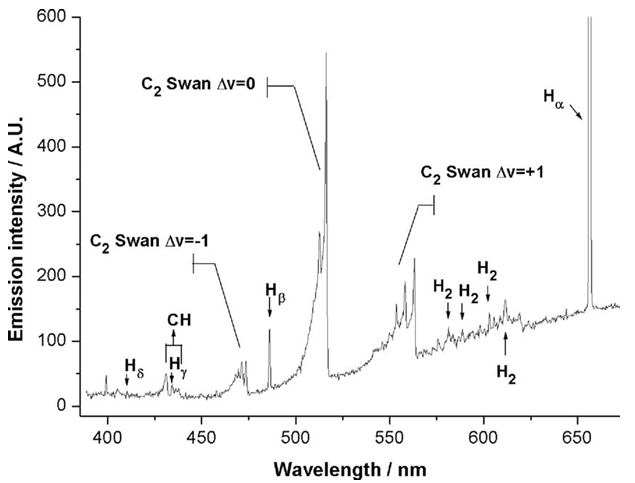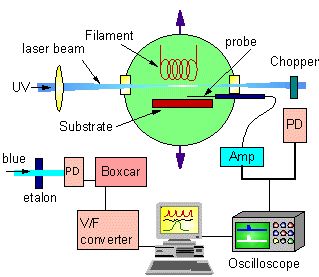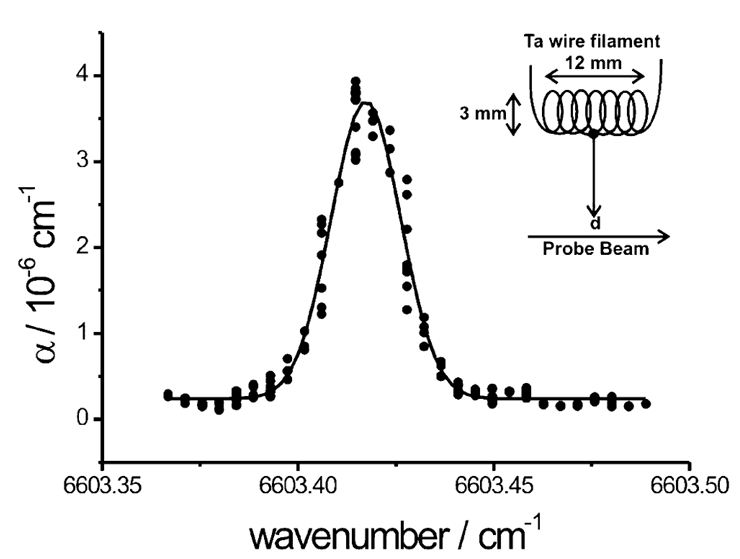 Laser Spectroscopy Diagnostics of the gas Phase During Diamond CVD
Laser Spectroscopy Diagnostics of the gas Phase During Diamond CVD
In order to understand the gas chemistry occurring within the hot plasma environment during diamond CVD we implemented a range of high-resolution spectroscopic techniques which enabled us to probe certain species within the plasma.
Optical Emission Spectroscopy
One of the simpest methods for gas-phase diagnostics is optical emission spectroscopy (OES), where the light emitted from the plamsa is fcused into a spectrometer where a diffraction grating disperses it onto a CCD detector. The resulting spectrum of intensity versus wavelength can be used to determine the identity of the emitting species within the plasma.

An optical emission spectrum of a CH4/H2Ar plasma used for diamond CVD.
Resonance Enhanced MultiPhoton Ionisation (REMPI)
REMPI is a laser diagnostic technique used to study the gas-phase species within a diamond reactor. A UV laser beam is passed into a CVD chamber and focused at a point (see schematic diagram, below). The position of the focus can be changed by moving the entire chamber vertically with respect to the laser beam. The laser wavelength is chosen so as to ionise a selected species, say H atoms, to produce H+ and electrons. The electrons can then be collected by a nearby biased metal probe and recorded as an electric current. The arrival time of the current at the probe is monitored as the laser pulses occur and a Gaussian lineshape is seen. This shows that the assumption that the local gas within the sampling region is in thermal equilibrium and can be approximated by a Maxwell-Boltzmann velocity distribution.

The FWHM of the spectral line can be converted to an absolute measure of the average kinetic temperature of the H atoms, and hence to their KE and velocity. The area beneath the line is proportional to the relative number density of H atoms at that position.
We used REMPI to obtain these data as a function of filament temperature, spatial distance from the filament, presence or absence of different types of substrate, etc.
Cavity Ring Down SpectroscopyCavity Ring Down Spectroscopy (CRDS) is a pulsed laser technique used to analyse the composition of gaseous sources, such as the methane/hydrogen gas mixtures within a diamond CVD reactor. It is extremely sensitive, and is one of the only spectroscopic techniques that can measure the absolute concentrations of certain species within the gas mixture. It utilises 2 highly reflecting (99.9%) mirrors which form a cavity containing the gas under investigation. The laser passes into the cavity and bounces back and forth between the 2 mirrors many times, producing an absorbance path length of several km. This very long path length is the reason for the sensitivity to low species concentrations. Eventually some of the laser light leaks out of the cavity and is detected by a photomultiplier. Depending on the reflectivity of the mirrors, each laser pulse decays at a known rate, called the ring-down time. If any species within the cavity absorbs the laser light, the ring-down time decreases. Thus by tuning the laser wavelength to one that is absorbed by one of the species in the cavity (e.g. H atoms or CH3), we can measure the concentration of the species. We employed this technique to look at the gases used in CVD diamond films made in a hot filament reactor and a MW plasma reactor, using CH4/H2 mixtures, and the effect upon H atom concentrations of N2 additions. These concetration values were crucial in tensioning the computational model for the gas-phase chemistry which was used in our later kMC calculations of the full growth process. |
|
Related Papers
- S.A. Redman, C. Chung and M.N.R. Ashfold, "H atom production in a hot filament chemical vapour deposition reactor", Diamond Relat. Mater., 8 (1999) 1383-87.
- S.A. Redman, C. Chung, K.N. Rosser and M.N.R. Ashfold, "Resonance Enhanced Multiphoton Ionisation Probing of H Atoms in a Hot Filament CVD Reactor" Phys. Chem. Chem. Phys. 1 (1999) 1415-1424.
- J.A. Smith, M.A. Cook, S.R. Langford, S.A. Redman and M.N.R. Ashfold, "Resonance enhanced multiphoton ionization probing of H atoms and CH3 radicals in a hot filament chemical vapour deposition reactor" Thin Solid Films 368 (2000) 169-175.
- M.A. Elliott, P.W. May, J. Petherbridge, S.M. Leeds and M.N.R. Ashfold, "Optical Emission Spectroscopic Studies of Microwave Enhanced Diamond CVD using CH4/CO2 Plasmas" Diamond Relat. Mater., 9 (2000) 311-316
- J.A. Smith, E. Cameron, M.N.R. Ashfold, Y.A. Mankelevich and N.V. Suetin, "On the mechanism of CH3 radical formation in hot filament activated CH4/H2 and C2H2/H2 gas mixtures", Diamond Relat. Mater., 10 (2001) 358-363
- Yu. A. Mankelevich, N.V.Suetin, M.N.R. Ashfold, J.A. Smith and E. Cameron, "Experimental data versus 3-D model calculations of HFCVD processes: Correlations and discrepancies" Diamond Relat. Mater., 10 (2001) 364-369.
- J.A. Smith, K.N. Rosser, H. Yagi, M.I. Wallace, P.W. May and M.N.R. Ashfold, "Diamond deposition in a DC-arc Jet CVD system: Investigations of the effects of nitrogen addition" Diamond Relat. Mater., 10 (2001) 370-375
- M.N.R. Ashfold, P.W. May, J.R. Petherbridge, K.N. Rosser, J.A. Smith, Y.A. Mankelevich and N.V. Suetin, "Unravelling aspects of the gas phase chemistry involved in diamond chemical vapour deposition", Phys. Chem. Chem. Phys., 3 (2001) 3471-3485.
- J.A. Smith, J.B. Wills, H.S. Moores, A.J. Orr-Ewing, Y.A. Mankelevich and N.V. Suetin, "Effects of NH3 and N2 additions to hot filament activated CH4/H2 gas mixtures", J. Appl. Phys. 92 (2002) 672-681.
- Yu.A. Mankelevich, N.V. Suetin, M.N.R. Ashfold, W.E. Boxford, A.J. Orr-Ewing, J.A. Smith and J.B. Wills, "Chemical kinetics in carbon depositing d.c.-arc jet CVD reactors", Diamond Relat. Mater. 12 (2003) 383-90
- J.B. Wills, M.N.R. Ashfold, A.J. Orr-Ewing, Y.A. Mankelevich and N.V. Suetin, "Number density and temperature of acetylene in hot-filament and arc-jet activated CH4/H2 gas mixtures measured using diode laser cavity ring-down absorption spectroscopy", Diamond Relat. Mater. 12 (2003) 1346-1356
- C.J. Rennick , A.G. Smith, J.A. Smith , J.B. Wills, A.J. Orr-Ewing , M.N.R. Ashfold, Yu.A. Mankelevich, N.V. Suetin, "Improved characterisation of C2 and CH radical number density distributions in a DC arc jet used for diamond chemical vapour deposition", Diamond Relat. Mater. 13 (2004) 561-8
- A. Cheesman, J. A. Smith, M. N. R. Ashfold, N. Langford, S. Wright, G. Duxbury, "Application of a Quantum Cascade Laser for Time-Resolved, in Situ Probing of CH2 and CH2HH2/HH2 Gas Mixtures during Microwave Plasma Enhanced Chemical Vapor Deposition of Diamond", J. Phys. Chem. A 110 (2006) 2821-8.
- Yu. A. Mankelevich, M.N.R. Ashfold and A.J. Orr-Ewing, "Measurement and modeling of Ar/H2/CH4 arc jet discharge chemical vapor deposition reactors. I. Intercomparison of derived spatial variations of H atom, C2, and CH radical densities", J. Appl. Phys. 102 (2007) 063309 1-13.
- Yu. A. Mankelevich, M.N.R. Ashfold and A.J. Orr-Ewing, "Measurement and modeling of Ar/H2/CH4 arc jet discharge chemical vapor deposition reactors. II. Intercomparison of derived spatial variations of H atom, C2, and CH radical densities", J. Appl. Phys. 102 (2007) 063310 1-11.
- D.W. Comerford, U.F.S. D'Haenens-Johansson, J.A. Smith, M.N.R. Ashfold, Yu.A. Mankelevich, "Filament seasoning and its effect on the chemistry prevailing in hot filament activated gas mixtures used in diamond chemical vapour deposition", Thin Solid Films 516 (2008) 521-5. [doi: 10.1016/j.tsf.2007.06.114]
- J. Ma, J.C. Richley, M.N.R. Ashfold, Yu.A. Mankelevich, "Probing the plasma chemistry in a microwave reactor used for diamond chemical vapor deposition by cavity ring down spectroscopy", J. Appl. Phys. 104 (2008) 103305. [doi: 10.1063/1.3021095]
- Yu.A. Mankelevich, M.N.R. Ashfold, J. Ma, "Plasma-chemical processes in microwave plasma-enhanced chemical vapor deposition reactors operating with C/H/Ar gas mixtures" J. Appl. Phys. 104 (2008) 113304. [doi: 10.1063/1.3035850]
- J. Ma, M. N. R. Ashfold, Yu. A. Mankelevich, "Validating optical emission spectroscopy as a diagnostic of microwave activated CH4/Ar/H2 plasmas used for diamond chemical vapor deposition", J. Appl. Phys. 105 (2009) 043302, p1-12. [doi: 10.1063/1.3078032]
- J. Ma, A. Cheesman, M.N.R. Ashfold, K.G. Hay, S. Wright, N. Langford, G. Duxbury, Yu.A. Mankelevich, "Quantum cascade laser investigations of CH4 and C2H2 interconversion in hydrocarbon/H2 gas mixtures during microwave plasma enhanced chemical vapor deposition of diamond", J. Appl. Phys. 106 (2009) 033305. [doi: 10.1063/1.3176971]
- J.E. Butler, Y.A. Mankelevich, A. Cheesman, J. Ma and M.N.R. Ashfold, "Understanding the chemical vapor deposition of diamond: recent progress", J. Phys.: Cond. Matter 21 (2009) 364201. [doi: 10.1088/0953-8984/21/36/364201].
- Jie Ma, J.C. Richley, D.R.W. Davies, A. Cheesman, M.N.R. Ashfold and Y.A. Mankelevich, "Spectroscopic and modelling investigations of the gas phase chemistry and consumption in microwave plasma activated B2H6/Ar/H2 gas mixtures", J. Phys. Chem. A. 114 (2010) 2447-63. [doi: 10.1021/jp9094694]
- Jie Ma, J.C. Richley, D.R.W. Davies, M.N.R. Ashfold and Y.A. Mankelevich, "Spectroscopic and modeling investigations of the gas phase chemistry and composition in microwave plasma activated B2H6/CH4/Ar/H2 gas mixtures", J. Phys. Chem. A. 114 (2010) 10076-89. [doi: 10.1021/jp104532y]
- Y.A. Mankelevich, M.N.R. Ashfold, D.W. Comerford, Jie Ma and J.C. Richley, "Boron doping: B/H/C/O gas phase chemistry; H atom density dependences on pressure and wire temperature; puzzles regarding the gas-surface mechanism", Thin Solid Films 519 (2011) 4421-5. [doi: 10.1016/j.tsf.2011.01.328]
- M.W. Kelly, J.C. Richley, C.M. Western, M.N.R. Ashfold, Y.A. Mankelevich, "Exploring the Plasma Chemistry in Microwave Chemical Vapor Deposition of Diamond from C/H/O Gas Mixtures", J. Phys. Chem. A 116 (2012) 9431-46. [doi: 10.1021/jp306190n]
- J.C. Richley, M.W. Kelly, M.N.R. Ashfold, Y.A. Mankelevich, "Optical Emission from Microwave Activated C/H/O Gas Mixtures for Diamond Chemical Vapor Deposition", J. Phys. Chem. A 116 (2012) 9447-58. [doi: 10.1021/jp306191y]
- B.S. Truscott, M.W. Kelly, K.J. Potter, M. Johnson, M.N.R. Ashfold, "Microwave Plasma-Activated Chemical Vapour Deposition of Nitrogen-Doped Diamond, I: N2/H2 and NH3/H2 Plasmas", J. Phys. Chem. A 119 (2015) 12962-12976. [doi: 10.1021/acs.jpca.5b09077].
- B.S. Truscott, M.W. Kelly, K.J. Potter, M. Johnson, M.N.R. Ashfold, "Microwave Plasma-Activated Chemical Vapour Deposition of Nitrogen-Doped Diamond, II: N2/H2 and NH3/H2 Plasmas", J. Phys. Chem. A 120 (2016) 8537-8549. [doi: 10.1021/acs.jpca.5b09077].
- M.N.R. Ashfold, E.J.D. Mahoney, S. Mushtaq, B S. Truscott and Yu.A. Mankelevich, "What [plasma used for growing] diamond can shine like flame?", Chem. Comm. 53 (2017) 10482. [doi: 10.1039/c7cc05568d].
- E.J.D. Mahoney, B.S. Truscott, M.N.R. Ashfold, Yu.A. Mankelevich, "Optical Emission from C2- Anions in Microwave-Activated CH4/H2 Plasmas for Chemical Vapor Deposition of Diamond", J. Phys. Chem. A 121 (2017) 2760-72. [doi: 10.1021/acs.jpca.7b00814].
- M.N.R. Ashfold, Yu.A. Mankelevich, "Two-dimensional modeling of diamond growth by microwave plasma activated chemical vapor deposition: Effects of pressure, absorbed power and the beneficial role of nitrogen on diamond growth", Diamond Relat. Mater. 137, (2023) 110097. [doi: 10.1016/j.diamond.2023.110097]

